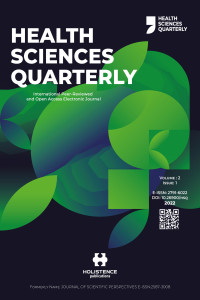Abstract
Surgical intervention is the treatment procedure of many diseases of the submandibular gland such as sialolithiasis, chronic sialoadenitis, and tumors. This study aims to analyze the management, outcomes, and complications of transcervical submandibular gland excision cases of a tertiary clinic and to discuss the results in light of the current literature knowledge. 120 cases who applied to a tertiary otorhinolaryngology clinic between 2014-2019 and who underwent submandibular gland excision were analyzed retrospectively. Postoperative histopathological results revealed that 108 cases were benign and 12 of cases were malignant. The most frequent benign pathology was chronic sialoadenitis in 82 cases. The most common non-malignant tumor was pleomorphic adenoma in 16 cases. Although the result obtained with fine-needle-biopsy was benign in 2 patients, the histopathological result after surgery was malignant (adenocarcinoma in 1 patient, mucoepidermoid carcinoma in 1 patient). As complications of surgery; marginal mandibular nerve injury in 11 cases (permanent in 2 cases) and hematoma in 7 cases were noted. A benign fine-needle aspiration biopsy result does not necessarily exclude malignancy in submandibular gland masses. As a result, we found that the percentage distribution of our submandibular gland histopathological results is consistent with the literature. Although marginal mandibular nerve injury is one of the most common complications of submandibular gland excision, transcervical submandibular gland excision is still a reliable surgery.
References
- 1. Hammett JT, Walker C. Sialolithiasis. In: StatPearls. Treasure Island (FL): StatPearls Publishing; July 18, 2021.
- 2. Rooper LM, Onenerk M, Siddiqui MT, Faquin WC, Bishop JA, Ali SZ. Nodular oncocytic hyperplasia: Can cytomorphology allow for the preoperative diagnosis of a nonneoplastic salivary disease?. Cancer Cytopathol. 2017;125(8):627-34. doi: 10.1002/cncy.21865.
- 3. Avishai G, Ben-Zvi Y, Ghanaiem O, Chaushu G, Gilat H. Sialolithiasis-Do early diagnosis and removal minimize post-operative morbidity?. Medicina (Kaunas). 2020;56(7):332. doi: 10.3390/medicina56070332.
- 4. Ellies M, Gottstein U, Rohrbach-Volland S, Arglebe C, Laskawi R. Reduction of salivary flow with botulinum toxin: extended report on 33 patients with drooling, salivary fistulas, and sialadenitis. Laryngoscope. 2004;114(10):1856-60. doi: 10.1097/00005537-200410000-00033.
- 5. Work WP, Hecht DW. Inflammatory diseases of the major salivary glands In: Papparella MM, Shumrick DF, editors. Otolaryngology. Vol 3. Philadelphia: WB Saunders; 1980.2235-43 p.
- 6. Abdel Razek AAK, Mukherji S. Imaging of sialadenitis. Neuroradiol J. 2017;30(3):205-15. doi: 10.1177/1971400916682752.
- 7. Diebold S, Overbeck M. Soft tissue disorders of the mouth. Emerg. Med. Clin. North Am. 2019;37(1):55-68. doi: 10.1016/j.emc.2018.09.006.
- 8. Acikalin RM, Ozbay I, Veyseller B. Submandibular gland excision: Analyse of 43 cases (in Turkish). Med Bull Haseki. 2014;52(3):199-201. doi: 10.4274/haseki.1374.
- 9. Siddiqui SJ. Sialolithiasis: an unusually large submandibular salivary stone. Br Dent J. 2002;193:89-91. doi: 10.1038/sj.bdj.4801491.
- 10. Choi HG, Bang W, Park B, Sim S, Tae K, Song CM. Lack of evidence that nephrolithiasis increases the risk of sialolithiasis: A longitudinal follow-up study using a national sample cohort. PLoS One. 2018;13(4):e0196659. doi: 10.1371/journal.pone.0196659.
- 11. Lustmann J, Regev E, Melamed Y. Sialolithiasis: A survey on 245 patients and a review of the literature. Int J Oral Maxillofacial Surg. 1990;19(3):135-8. doi: 10.1016/s0901-5027(05)80127-4.
- 12. Lim EH, Nadarajah S, Mohamad I. Giant submandibular calculus eroding oral cavity mucosa. Oman Med J. 2017;32(5):432-5. doi: 10.5001/omj.2017.81.
- 13. Emir H, Kaptan ZK, Uzunkulaoglu H, Dogan S. A rare case of asymptomatic bilateral submandibular gland sialolithiasis: a giant, fistulized calculus on the right and multiple calculi on the left. Ear Nose Throat J. 2010;89(10):502-4.
- 14. Yılmaz I, Cagıcı CA, Caylakli F, Akdogan V, Ozluoglu LN. Utility of fine-needle aspiration biopsy in head and neck masses (in Turkish). Kulak Burun Bogaz Ihtis Derg. 2008;18(4):211-5.
- 15. el Hag IA, Chiedozi LC, al Reyees FA, Kollur SM. Fine needle aspiration cytology of head and neck masses. Seven years’ experience in a secondary care hospital. Acta Cytol. 2003;47(3):387-92. doi: 10.1159/000326538.
- 16. Hernando M, Echarri RM, Taha M, Martin-Fragueiro L, Hernando A, Mayor GP. Surgical complications of submandibular gland excision. Acta Otorrinolaringol Esp. 2012;63:42-6. doi: 10.1016/j.otorri.2011.08.001.
- 17. Lee YY, Wong KT, King AD, Ahuja AT. Imaging of salivary gland tumors. Eur. J. Radiol. 2008;66(3):419-36. doi: 10.1016/j.ejrad.2008.01.027.
- 18. Papaspyrou G, Werner JA, Sesterhenn AM. Transcervical extirpation of the submandibular gland: The University of Marburgexperience. Eur Arch Otorhinolaryngol. 2014; 271: 2009-12. doi: 10.1007/s00405-013-2720-9.
- 19. Beahm DD, Peleaz L, Nuss DW, Schaitkin B, Sedlmayr JC, Rivera-Serrano CM, et. al. Surgical approaches to the submandibular gland: A review of literature. Int J Surg. 2009;7(6):503-9. doi: 10.1016/j.ijsu.2009.09.006.
Details
| Primary Language | English |
|---|---|
| Subjects | Health Care Administration |
| Journal Section | Research Article |
| Authors | |
| Publication Date | January 27, 2022 |
| Published in Issue | Year 2022 Volume: 2 Issue: 1 |

